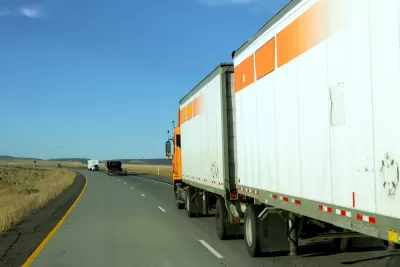The U.S. Environmental Protection Agency and U.S. Department of Transportation jointly issued final standards on Aug. 16 to reduce emissions and improve fuel economy for heavy duty trucks which currently average about six miles per gallon.

"The Obama administration on [Aug. 16] issued aggressive new emissions standards for heavy-duty trucks," reports Bill Vlasic for The New York Times. "The rules are expected to achieve better fuel efficiency and a bigger cut in pollution than the version that was first proposed last year."
Officials said the new standards would require up to a 25 percent reduction in carbon emissions for big tractor-trailers over the next 10 years, and somewhat smaller improvements for delivery trucks, school buses and other large vehicles.
As with regulations on emission standards for passenger vehicles (which include light trucks), the rules are jointly issued by the U.S. Environmental Protection Agency (EPA) and the U.S. Department of Transportation, specifically through the National Highway Traffic Safety Administration. EPA regulates greenhouse gas emissions while NHTSA regulates fuel efficiency, using the term Corporate Average Fuel Economy, or CAFE.
EPA Administrator Gina McCarthy "said the standards were 'ambitious but achievable,' and were decided after hundreds of meetings in the last year with groups representing truck manufacturers, fleet owners and environmental organizations," adds Vlasic. But they will add to the costs of new trucks, though they achieve cost savings too.
Analysts have estimated the cost of complying with the new standards at $12,000 a vehicle. [Transportation Secretary Anthony Foxx] said those investments would be outweighed by larger economic gains such as reduced fuel consumption.
[He] said the trucking industry would save an estimated $170 billion in fuel costs through 2027 and reduce petroleum consumption by two billion barrels over the lifetime of the vehicles sold under the new rules.
The new standards are welcome news for environmentalists. Transportation supplanted power plants last February as the largest source of carbon emissions in the U.S. economy. "Within the transportation sector, heavy-duty vehicles are the fastest-growing contributors to [greenhouse gas] emissions," according to an EPA-NHTSA fact sheet [PDF] on the new standards.
FULL STORY: New Rules Require Heavy-Duty Trucks to Reduce Emissions by 25% Over the Next Decade

Alabama: Trump Terminates Settlements for Black Communities Harmed By Raw Sewage
Trump deemed the landmark civil rights agreement “illegal DEI and environmental justice policy.”

Planetizen Federal Action Tracker
A weekly monitor of how Trump’s orders and actions are impacting planners and planning in America.

Why Should We Subsidize Public Transportation?
Many public transit agencies face financial stress due to rising costs, declining fare revenue, and declining subsidies. Transit advocates must provide a strong business case for increasing public transit funding.

Understanding Road Diets
An explainer from Momentum highlights the advantages of reducing vehicle lanes in favor of more bike, transit, and pedestrian infrastructure.

New California Law Regulates Warehouse Pollution
A new law tightens building and emissions regulations for large distribution warehouses to mitigate air pollution and traffic in surrounding communities.

Phoenix Announces Opening Date for Light Rail Extension
The South Central extension will connect South Phoenix to downtown and other major hubs starting on June 7.
Urban Design for Planners 1: Software Tools
This six-course series explores essential urban design concepts using open source software and equips planners with the tools they need to participate fully in the urban design process.
Planning for Universal Design
Learn the tools for implementing Universal Design in planning regulations.
Caltrans
Smith Gee Studio
Institute for Housing and Urban Development Studies (IHS)
City of Grandview
Harvard GSD Executive Education
Toledo-Lucas County Plan Commissions
Salt Lake City
NYU Wagner Graduate School of Public Service




























